The world has been grappling with an unprecedented health crisis since the end of 2019, a crisis that has reshaped our daily lives, economies, and global interactions. This crisis, commonly referred to as the COVID-19 pandemic, is caused by a novel coronavirus. But what exactly is this virus, and what is its name in English? In this article, we will delve into the origins, characteristics, and nomenclature of the virus responsible for the pandemic, providing a comprehensive understanding of the pathogen that has brought the world to a standstill.
The Origins of the Virus
The virus that causes COVID-19 is a member of the coronavirus family, a large group of viruses that can infect both animals and humans. Coronaviruses are known for causing respiratory infections, ranging from the common cold to more severe diseases such as Middle East Respiratory Syndrome (MERS) and Severe Acute Respiratory Syndrome (SARS). The novel coronavirus, however, was previously unknown to science before it emerged in Wuhan, China, in late 2019.
The exact origins of the virus are still under investigation, but it is widely believed to have originated in bats, with a possible intermediate host, such as a pangolin, facilitating its transmission to humans. The virus's ability to jump from animals to humans, a process known as zoonotic transmission, is a significant factor in its emergence as a global threat.
The Virus's Name in English
In English, the virus responsible for COVID-19 is officially namedSevere Acute Respiratory Syndrome Coronavirus 2 (SARS-CoV-2). This name was assigned by the International Committee on Taxonomy of Viruses (ICTV) in February 2020. The name reflects the virus's genetic similarity to the SARS-CoV virus that caused the 2002-2003 SARS outbreak, as well as its ability to cause severe respiratory illness.
The disease caused by SARS-CoV-2 is calledCoronavirus Disease 2019 (COVID-19), a name coined by the World Health Organization (WHO) in February 2020. The "CO" stands for corona, "VI" for virus, "D" for disease, and "19" for the year it was first identified.

Characteristics of SARS-CoV-2
SARS-CoV-2 is an enveloped, positive-sense, single-stranded RNA virus. Its genetic material is encased in a lipid bilayer, which is studded with spike proteins that give the virus its characteristic crown-like appearance under an electron microscope—hence the name "coronavirus."
The spike proteins play a crucial role in the virus's ability to infect human cells. They bind to the angiotensin-converting enzyme 2 (ACE2) receptor on the surface of human cells, particularly those in the respiratory tract, facilitating viral entry and replication. This mechanism is central to the virus's pathogenicity and its ability to cause widespread infection.
Transmission and Symptoms
SARS-CoV-2 is primarily transmitted through respiratory droplets produced when an infected person coughs, sneezes, talks, or breathes. It can also spread by touching surfaces contaminated with the virus and then touching the face, particularly the mouth, nose, or eyes.
The symptoms of COVID-19 vary widely, ranging from mild to severe. Common symptoms include fever, cough, fatigue, loss of taste or smell, and shortness of breath. In severe cases, the disease can lead to pneumonia, acute respiratory distress syndrome (ARDS), multi-organ failure, and death. Certain populations, such as the elderly and those with underlying health conditions, are at higher risk of severe illness.

Global Impact and Response
The rapid spread of SARS-CoV-2 led to the declaration of a global pandemic by the WHO on March 11, 2020. Governments worldwide implemented various measures to curb the spread of the virus, including lockdowns, travel restrictions, social distancing, and the promotion of hygiene practices such as handwashing and mask-wearing.
The pandemic has had profound social, economic, and psychological impacts. Healthcare systems have been overwhelmed, economies have contracted, and millions of people have lost their lives. The crisis has also highlighted disparities in healthcare access and the importance of global cooperation in addressing public health emergencies.
Vaccines and Treatments
In response to the pandemic, an unprecedented global effort was launched to develop vaccines and treatments for COVID-19. Multiple vaccines were developed, tested, and authorized for emergency use within a year of the virus's identification—a remarkable feat in the history of medicine. These vaccines, including those developed by Pfizer-BioNTech, Moderna, AstraZeneca, and Johnson & Johnson, have played a crucial role in reducing the spread of the virus and mitigating its impact.
In addition to vaccines, various treatments have been explored, including antiviral drugs like remdesivir, monoclonal antibodies, and corticosteroids. While these treatments have shown varying degrees of efficacy, vaccination remains the most effective tool in controlling the pandemic.

The Future of SARS-CoV-2
As the world continues to navigate the pandemic, the future of SARS-CoV-2 remains uncertain. The virus has shown a propensity for mutation, leading to the emergence of new variants, some of which have increased transmissibility or the ability to evade immune responses. Ongoing surveillance, research, and adaptation of public health strategies are essential to managing the evolving threat posed by the virus.
In conclusion, the virus responsible for the COVID-19 pandemic is named Severe Acute Respiratory Syndrome Coronavirus 2 (SARS-CoV-2) in English. Its emergence has underscored the interconnectedness of our world and the importance of preparedness, collaboration, and innovation in addressing global health challenges. As we move forward, understanding the virus and its impact will be crucial in shaping a resilient and equitable future for all.
发表评论
暂时没有评论,来抢沙发吧~